
Principles and Applications of Asymmetric Synthesis
.pdf1.3 DETERMINING ENANTIOMER COMPOSITION |
19 |
when NaBH4 or LiAlH4 was used. It was found later that the wrong value of
‡4:89 for the speci®c rotation was caused by trace amounts of a highly dextrorotatory impurity in the product. For this and other reasons, many enantiomer compositions determined by this method in earlier years have now been found to be incorrect.
1.3.2The Nuclear Magnetic Resonance Method
NMR spectroscopy cannot normally be used directly for discriminating enantiomers in solution. The NMR signals for most enantiomers are isochronic under achiral conditions. However, NMR techniques can be used for the determination of enantiomer compositions when diastereomeric interactions are introduced to the system.
1.3.2.1Nuclear Magnetic Resonance Spectroscopy Measured in a Chiral Solvent or with a Chiral Solvating Agent. One method of NMR analysis for enantiomer composition is to record the spectra in a chiral environment, such as a chiral solvent or a chiral solvating agent. This method is based on the diastereomeric interaction between the substrate and the chiral environment applied in the analysis.
The ®rst example found in the literature was the use of this method in distinguishing the enantiomers of 2,2,2-tri¯uoro-1-phenylethanol. This was realized by recording the 19F NMR of the compound in …ÿ†-a-phenethylamine.11 Burlingame and Pirkle12 found that the ee values could also be determined by studying the 1H NMR. Later it was found13 that the determination can also be achieved in achiral solvents in the presence of certain chiral compounds, namely, chiral solvating agents. In these cases, the determination was achieved based on the diastereomeric interaction between the substrate and the chiral solvating agent. Sometimes, the observed chemical shift di¨erence is very small, making the analysis di½cult. This problem may be overcome by using a higher ®eld NMR spectrometer or recording the spectra at lower temperature.
1.3.2.2Nuclear Magnetic Resonance with a Chiral Chemical Shift Reagent. Lanthanide complexes can serve as weak Lewis acids. In nonpolar solvents (e.g., CDCl3, CCl4, or CS2) these paramagnetic salts are able to bind Lewis bases, such as amides, amines, esters, ketones, and sulfoxides. As a result, protons, carbons, and other nuclei are usually deshielded relative to their positions in the uncomplexed substrates, and the chemical shifts of those nuclei are altered. The extent of this alteration depends on the strength of the complex and the distance of the nuclei from the paramagnetic metal ion. Therefore, the NMR signals of di¨erent types of nuclei are shifted to di¨erent extents, and this leads to spectral simpli®cation. The spectral nonequivalence observed in the presence of chiral chemical shift reagents (CSR) can be explained by the difference in geometry of the diastereomeric CSR±chiral substrate complexes, as
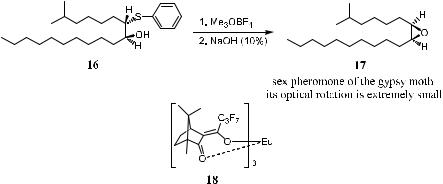
20 INTRODUCTION
well as the di¨erent magnetic environment of the coordinated enantiomers that causes the anisochrony.14
Achiral lanthanide shifting reagents may be used to enhance the anisochrony of diastereomeric mixtures to facilitate their quantitative analysis. Chiral lanthanide shift reagents are much more commonly used to quantitatively analyze enantiomer compositions. Sometimes it may be necessary to chemically convert the enantiomer mixtures to their derivatives in order to get reasonable peak separation with chiral chemical shift reagents.
Sometimes the enantiomer composition of a compound cannot be directly determined using a chiral CSR. In this case, another compound that can be related to the target compound will be chosen for the determination of enantiomer composition.
Disparlure (cis-7,8-epoxy-2-methyloctadecane 17), as shown in Scheme 1±3, has been identi®ed as the sex pheromone of the gypsy moth. Because the two alkyl substituents of disparlure are very similar, the molecule is e¨ectively meso from an experimental viewpoint. The optical rotation of disparlure is extremely small. Estimates from ‡0:2 to ‡0:7 have been cited for the optically pure material.15 Therefore, it is di½cult to determine the optical purity of synthetic samples by the optical rotation method. Furthermore, attempts to determine the enantiomer excess using chiral solvating agents and chiral lanthanide shift agents in conjunction with 1H or 13C NMR failed to give satisfactory results. Pirkle and Rinaldi16 succeeded in determining the enantiomeric purity of 17 by utilizing a chiral chemical shift reagent, tris[3-(hepta¯uoropropylhydroxymethlene)-d- camphorato]europium (III) (18) in the 13C NMR measurement of compound 16, an immediate precursor of disparlure (17). Examination of the 13C NMR spectrum of racemic disparlure precursor 16 in the presence of the chiral lanthanide reagent revealed the nonequivalent resonance signals for the aromatic ipsoor ortho-carbons of the enantiomers. Because the subsequent ring closure is stereospeci®c, the enantiomer composition of the product 17 should correspond to that of its precursor 16. From its 13C NMR, the synthesized precursor
Scheme 1±3. Determining enantiomer composition with chiral chemical shift reagent 18.
1.3 DETERMINING ENANTIOMER COMPOSITION |
21 |
16 was found to have such an enantiomeric purity that the minor enantiomer could not be detected. It was thus concluded that the synthetic disparlure 17 was enantiomerically pure.
The synthesis of lanthanide chemical shift reagents has been the objective of many groups owing to their e¨ect on NMR spectra simpli®cation. A drawback of the commonly used reagents is their sensitivity to water or acids. Tris(tetraphenylimido diphosphinato)praseodymium [Pr(tpip)3] has been developed as a CSR for the analysis of carboxylic acids.17 Furthermore, it has been found that dinuclear dicarboxylate complexes can be obtained through reactions with ammonium or potassium salts of carboxylic acids, and these compounds can be used to determine the enantiomer composition of carboxylic acids.18
1.3.2.3 Chiral Derivatizing Agents for Nuclear Magnetic Resonance Analysis. Chiral derivatizing agents are enantiomerically pure reagents that are used to convert test samples to diastereomers in order to determine their enantiomeric purity by NMR spectroscopy. The earliest NMR technique for the determination of enantiomer composition involved the derivatization and analysis of covalent diastereomer mixtures of esters and amides. The alcohols and amines were ®rst converted to the corresponding ester and amide derivatives via reaction with chiral derivatizing agents. The NMR spectra of these derivatives gave some easily identi®able signals for the diastereotopic nuclei, and the enantiomer compositions were calculated from the integrated areas of these signals.19 One of these ®rst-generation chiral derivatizing agents was (R)- …ÿ†-methylmandelyl chloride.20 Later it was found that the derivative of this reagent had a tendency to epimerize at the a-position of the carbonyl group or to undergo kinetic resolution.21
In 1973, Dale and Mosher22 proposed a reagent, a-methoxy-a-phenyl-a- tri¯uoromethyl acetic acid (19), in both the (R)- and (S)-form. This is now known as Mosher's acid. The chloride of the acid reacts with chiral alcohols (mostly secondary alcohols) to form diastereomeric mixtures called MTPA esters or Mosher's esters. This acid was initially designed to minimize the epimerization problem.23 There are two advantages in using this compound: (1) The epimerization of the chiral a-C is avoided because of the absence of the a-proton; and (2) the introduction of a CF3 group makes it possible to analyze the derivatives by means of 19F NMR, which simpli®es the analysis process. Peak overlapping is generally not observed, and the 19F NMR signals are far better separated than are the 1H NMR peaks. In most cases, puri®cation of the reaction mixture is not necessary. This compound is also used in the chromatographic determination of enantiomer compositions, as well as in the determination of absolute con®gurations.
On account of the magnetic nonequivalence of the a-tri¯uoromethyl group and the a-methoxy group in diastereomeric MTPA esters, the enantiomer compositions of alcohols can be determined by observing the NMR signals of the CH3O or CF3 group in their corresponding MTPA esters (Scheme 1±4). Similarly, due to the di¨erent retention times of diastereomeric MTPA esters in
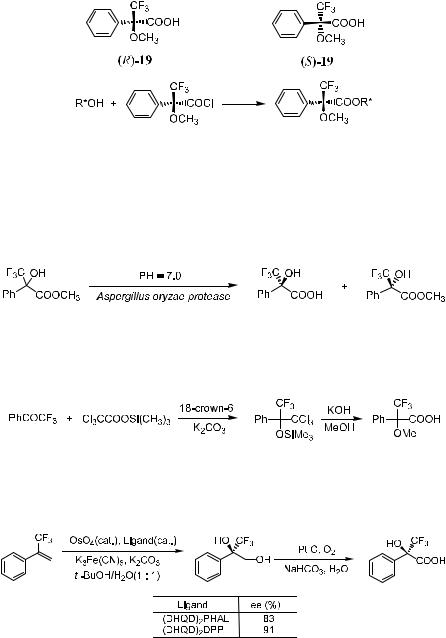
22 INTRODUCTION
Scheme 1±4. Application of Mosher's acid.
GC or HPLC, the diastereomeric derivatives may be separated by chromatographic means.
Following Mosher's report, several publications appeared showing the preparation of Mosher's acid. One example is the chemoenzymatic preparation of Mosher's acid using Aspergillus oryzae protease (Scheme 1±5)24:
Scheme 1±5. Chemoenzymatic preparation of Mosher's acid.
Another new and simple synthesis of Mosher's acid was reported by Goldberg and Alper25 (Scheme 1±6):
Scheme 1±6. New synthesis of Mosher's acid.
Bennani et al.26 also reported a short route to Mosher's acid precursors via catalytic asymmetric dihydroxylation (Scheme 1±7):
Scheme 1±7. Synthesis of Mosher's acid precursors.
Similarly, Mosher-type amines have been introduced for determining the enantiomer composition of chiral carboxylic acids (Fig. 1±10)27:
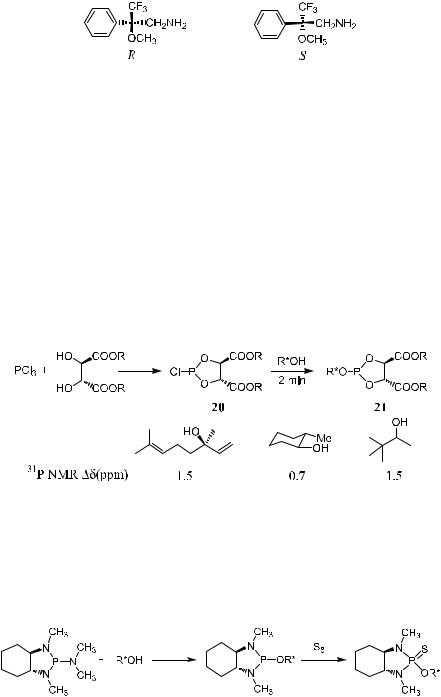
1.3 DETERMINING ENANTIOMER COMPOSITION |
23 |
||||
|
|
|
|
|
|
|
|
|
|
|
|
|
|
|
|
|
|
Figure 1±10. Mosher-type amines.
1.3.3 Some Other Reagents for Nuclear Magnetic Resonance Analysis
Various chiral derivatizing agents have been reported for the determination of enantiomer compositions. One example is determining the enantiomeric purity of alcohols using 31P NMR.28 As shown in Scheme 1±8, reagent 20 can be readily prepared and conveniently stored in tetrahydrofuran (THF) for long periods. This compound shows excellent activity toward primary, secondary, and tertiary alcohols. To evaluate the utility of compound 20 for determining enantiomer composition, some racemic alcohols were chosen and allowed to react with 20. The diastereomeric pairs of derivative 21 exhibit clear di¨erences in their 31P NMR spectra, and the enantiomer composition of a compound can then be easily measured (Scheme 1±8).
Scheme 1±8. Chemical shift di¨erences in 31P NMR (Dd[ppm]) of some alcohol derivatives with 20.
Other derivatizing reagents that can be used as simple and e½cient reagents for determining the enantiomer composition of chiral alcohols using the 31P NMR method are shown below (Scheme 1±9 and Fig. 1±11)29±32:
Scheme 1±9. Chiral derivatizing agents used in 31P NMR analysis.
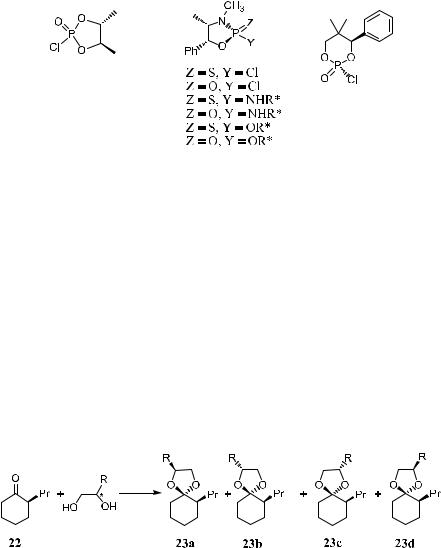
24 INTRODUCTION
Figure 1±11. Some new compounds used as derivatizing agents.
a-Methoxylphenyl acetic acid can be used as an NMR chiral CSR for determining the enantiomer composition of sulfoxides.33
1.3.4 Determining the Enantiomer Composition of Chiral Glycols or Cyclic Ketones
Hiemstra and Wynberg reported34 the determination of the enantiomer composition of 3-substituted cyclohexanones by observing the 13C NMR signals of C-2 and C-6 in the corresponding cyclic ketals, which were prepared via the reaction of the ketones with enantiomerically pure 2,3-butanediol. This method has also been applied in determining enantiomeric composition of chiral aldehydes via the formation of acetals.35 Similarly, chiral 2-substituted cyclohexanone 22 has been used for determining the enantiomer composition of chiral 2-substituted- 1,2-glycols via 13C NMR or HPLC analysis (Scheme 1±10).36
Scheme 1±10. Formation of ketals from glycols and 2-substituted cyclohexanone 22.
Compound 22 can be conveniently prepared in multigram quantities and has been found to be useful for assessing the enantiomeric purity of 1,2-glycols. Because the ketal carbon represents a new chiral center, the formation of four diastereomers is possible. However, the diastereomeric pair 23a and 23b (or 23c and 23d ) shows 1:1 peak height in 13C NMR or equal peak areas in HPLC; the diastereomer composition measured by the ratio of 23a to 23b or 23c to 23d re¯ects the enantiomer composition of the original 1,2-glycol.

1.3 DETERMINING ENANTIOMER COMPOSITION |
25 |
||||
|
|
|
|
|
|
Scheme 1±11. Conversion of ketone to aminal.
Similarly, the enantiomer compositions of ketones or aldehydes can be determined using a chiral 1,2-glycol by converting the ketones or aldehydes to the corresponding ketals or acetals. The derivatization of chiral cyclic ketones or aldehydes to diastereomeric aminals by reacting the ketones or aldehydes with an enantiomerically pure diamine is also an e½cient and fast method for determining their enantiomer composition. Enantiomerically pure (R,R)-1,2- diphenylethylene-diamine 25 can react readily with 3-substituted cyclohexanone 24 to form the diastereomeric aminal 26 (Scheme 1±11). The NMR spectrum of 26 in either CDCl3 or C6D6 shows a better signal separation than that of the ketals.37 The main advantage lies in the ease of manipulation of the sample. When ketone 24 and diamine 25 (normally in slight excess) are mixed directly in an NMR tube, the reaction is completed in a few seconds.
In the case of 3-substituted cyclopentanones or cycloheptanones, derivatization with diamine is slower, and the reaction time ranges from a few minutes to several hours. This method is not applicable to acyclic ketones and enones.
The general pattern of the spectra of aminals is similar to that of the corresponding ketals, and the measurement of enantiomer composition can be done on the same carbon nuclei. In addition, the signals are clearly distinguishable in the aminals, giving more accurate results.38
1.3.5Chromatographic Methods Using Chiral Columns
One of the most powerful methods for determining enantiomer composition is gas or liquid chromatography, as it allows direct separation of the enantiomers of a chiral substance. Early chromatographic methods required the conversion of an enantiomeric mixture to a diastereomeric mixture, followed by analysis of the mixture by either GC or HPLC. A more convenient chromatographic approach for determining enantiomer compositions involves the application of a chiral environment without derivatization of the enantiomer mixture. Such a separation may be achieved using a chiral solvent as the mobile phase, but applications are limited because the method consumes large quantities of costly chiral solvents. The direct separation of enantiomers on a chiral stationary phase has been used extensively for the determination of enantiomer composition. Materials for the chiral stationary phase are commercially available for both GC and HPLC.
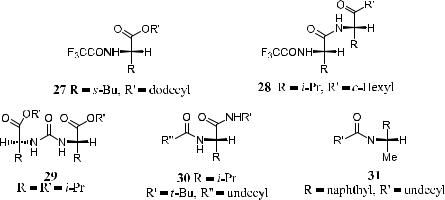
26 INTRODUCTION
Figure 1±12. Basic structures of chiral materials used as the stationary phase in gas chromatographic resolution via hydrogen bonding.
1.3.5.1 Gas Chromatography. A very commonly used method for the analysis of mixtures of enantiomers is chiral GC.39±41 In addition to being quick and simple, this sensitive method is normally una¨ected by trace impurities. The method is based on the principle that molecular association between the chiral stationary phase and the sample may lead to some chiral recognition and su½cient resolution of the enantiomers. The chiral stationary phase contains an auxiliary resolving agent of high enantiomeric purity. The enantiomers to be analyzed undergo rapid and reversible diastereomeric interactions with the stationary phase and hence may be eluted at di¨erent rates (indicated as tR, the retention time). Two examples of chiral stationary phases used for gas chromatography are illustrated below.
Hydrogen Bonding of the Substrates with the Stationary Phase. In this category (Fig. 1±12), the chiral stationary phase normally contains amide bonds that can provide hydrogen bonding sites for the substrates.42 Such chiral stationary phases were initially designed for amino acid analysis based on the assumption that hydrogen bonding between the amino acid substrate and the chiral stationary phase can provide a small degree of enantioselectivity su½cient for the quantitative analysis of the enantiomer compositions of chiral amino acids.43 This separation can be ampli®ed by using long capillary columns.
Complexation with Chiral Metal Complexes. This idea was ®rst suggested by Feibush et al.44 The separation is realized by the dynamic formation of diastereomeric complexes between gaseous chiral molecules and the chiral stationary phase in the coordination sphere of metal complexes. A few typical examples of metal complexes used in chiral stationary phase chromatography are presented in Figure 1±13.45
Separation of enantiomeric or diastereomeric mixtures by GC is a good
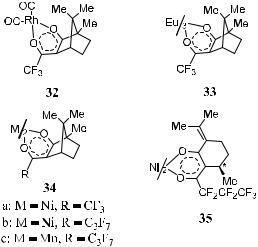
1.3 DETERMINING ENANTIOMER COMPOSITION |
27 |
Figure 1±13. Chiral metal chelates for enantiomer resolution by complexation gas chromatography.
method for determining enantiomer compositions. However, this method is limited to samples that are both volatile and thermally stable. Normally, if the compound to be separated has a low boiling point (lower than 260 C, for example), or it can be converted to a low boiling substance, and no racemization occurs during the analysis, it is possible to analyze it by GC. In general, the lower the temperature at which the compound is eluted, the greater the opportunity for a clean separation. If the compound has a high boiling point, or the compound tends to decompose or racemize at high temperature, HPLC using either a chiral stationary phase or a chiral mobile phase would be the choice of separation.
1.3.5.2 Liquid Chromatography. The development of rapid, simple liquid chromatographic methods for determining the enantiomeric purity of chiral compounds is probably one of the most important developments in the study of asymmetric synthesis in the last 10 years. Several books have been published providing thorough evaluations of various enantiomeric separation techniques and their practical applications.46
Initially, chiral stationary phases for chiral liquid chromatography were designed for preparative purposes, mostly based on the concept of ``three-point recognition''.47 Pirkle and other scientists48 developed a series of chiral stationary phases that usually contain an aryl-substituted chiral compound connected to silica gel through a spacer. Figure 1±14 depicts the general concept and an actual example of such a chiral stationary phase.
Another chiral stationary phase is modi®ed cyclodextrin. Cyclodextrins are cyclic chiral carbohydrates composed of six, seven, or eight glucopyranose

28 INTRODUCTION
Figure 1±14. Chiral stationary phase for high-performance liquid chromatography.
units designated as a-, b-, and g-cyclodextrin, respectively. Cyclodextrins are cylinder-shaped molecules with an axial void cavity. Their outer surface is hydrophilic, and therefore they are soluble in water. The cavity is nonpolar and can include other nonpolar molecules of appropriate dimensions and bind them through hydrophobic interactions.49
The complexation of cyclodextrin is highly selective. The inclusion processes are in¯uenced mainly by the hydrophobicity and shape of the guest molecules. Speci®cally, the guest molecules must ®t the cyclodextrin cavity. Complexation processes occurring in solution are reversible, and the equilibration in solution is relatively fast. For these reasons, cyclodextrin immobilized on silica gel is also used for chromatographic separation of chiral compounds, especially for compounds containing aromatic groups.50 An aromatic group on the substrate is essential for getting enantioselective binding through interaction with the glycosidic oxygen atoms. A substrate without an aromatic group will occupy random positions within the cavity and consequently lose enantioselectivity.51
1.3.6 Capillary Electrophoresis with Enantioselective Supporting Electrolytes
Electrophoresis is based on the transport of electrically charged compounds in a gel or a bu¨er solution under the in¯uence of an electric ®eld. The instrumentation involves a capillary tube ®lled with bu¨er solution and placed between two bu¨er reservoirs. The electric ®eld is applied by means of a high-voltage power supply. This is similar to a chromatographic method in which the enantiomer mixture forms diastereomer complexes with a chiral mobile phase to accomplish the separation. In chromatographic separation, the driving force comes from the mobile phase, whereas in electrophoresis the driving force is the electroosmotic and electrophoretic action. Di¨erences in complexation constants cause these transient charged species to acquire di¨erent mobilities under the in¯uence of the applied electric ®eld. It should be noted that in electrophoresis no mobile phase is used. The method depends on the di¨erent migration rates of charged enantiomers in a chiral supporting electrolyte. The method is fast and highly sensitive, which permits the rapid (about 10 minutes) and accurate analysis of samples in femtomolar concentration.52
Capillary electrophoresis (CE) was originally developed as a microanalytical technique for analysis and puri®cation of biopolymers. The separation of bio-
